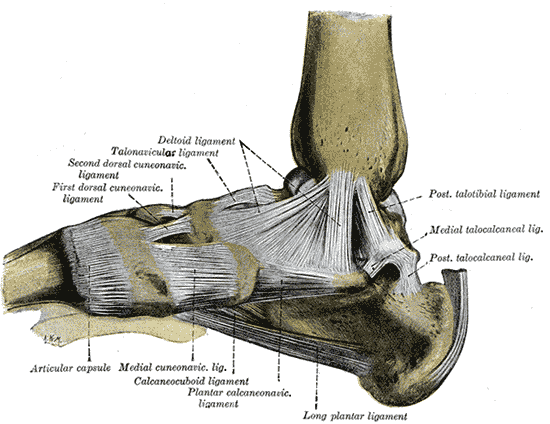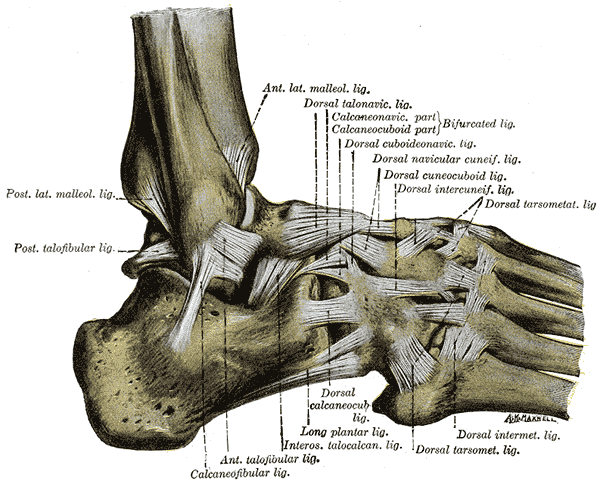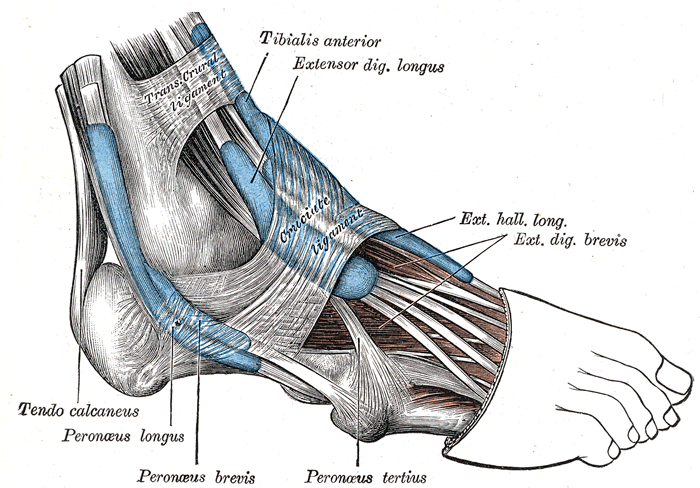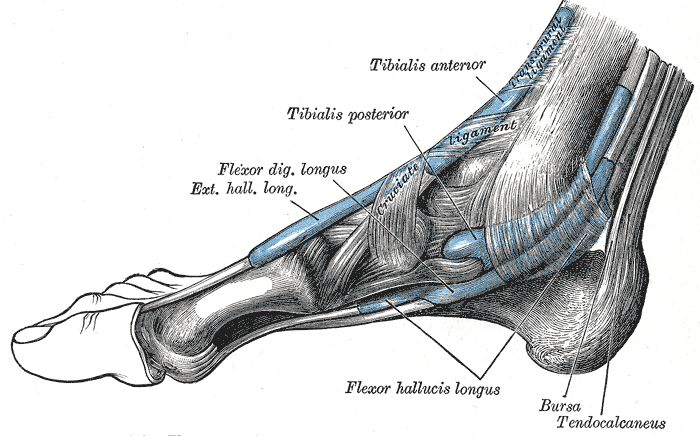Chronic Ankle Sprains
Ankle Sprains are an injury that almost all of us have dealt with on some level, and believe it or not, over 25,000 Americans sprain an ankle each and every day of the year. Most of us have never had the severe pain associated with a terrible sprain (the kind of injury that puts us on crutches), but we have nearly all “rolled” an ankle before. The foot and ankle are made up of almost thirty bones that are held together with ELASTIC, COLLAGEN-BASED CONNECTIVE TISSUES (ligaments, tendons, muscles, and fascia). Why is this important to know? Because fixing injured connective tissues and the associated joint restriction is what this website is all about!
If you have read my website, you are aware that it is all about treating FASCIAL ADHESIONS, TENDINOPATHIES, and LIGAMENT INJURIES.
These are the very problems that frequently occur in ankles and feet
after the biomechanical changes brought on by a sprain. Just looking at
the pictures gives you an idea of how many tissues make up the foot and
ankle.
| MEDIAL ANKLE SPRAIN |
 |
| BOTTOM THE FOOT |
 |
| LATERAL ANKLE SPRAIN |
 |
| OUTER (LATERAL) ANKLE SPRAIN |
 |
| INNER (MEDIAL) ANKLE SPRAIN |
 |
Although all sorts of ankle injuries are possible, there are essentially two main ways that people sprain an ankle. You can roll it to the outside (Inversion Sprain or Lateral Ankle Sprain) or you can roll it inward (Eversion Sprain or Medial Ankle Sprain). The inversions are incredibly common, while I rarely see a Medial Ankle Sprain unless a person has had another person roll up on their ankle like you might see in football or other contact sports.
Ankle Sprains are Graded according to their severity (the amount of tissue damage that they cause. Bear in mind that this chart goes hand in hand with my THREE TYPES OF PAIN post.
- GRADE I: A Grade I is a very simple injury. Tissues are “stretched” but not really torn. The prognosis for this type of injury is essentially 100%
- GRADE II: A Grade II is a bit more severe. There is some tearing of the ligaments and tissues. There will be some of the standard features of an ankle sprain; swelling, heat, pain, a diminished ability to bear weight, etc… If these are dealt with the proper way, the prognosis is good, and healing and rehab will take a few weeks to a couple of months. If they are not rehabbed properly and left to occur over and over, there will eventually be a more severe injury or build up of scar tissue — or more likely; both.
- GRADE III: Grade III sprains are a true bummer. You will have all of the symptoms of a Grade II, only worse. You will likely spend some time on crutches, and the healing time will be measured in months. Your ankle will never be the same after a Grade III sprain. Proper rehab is critical as are chiropractic adjustments (more on this shortly).
- AVULSION FRACTURE: Although it’s called a fracture, an avulsion fracture of the ankle is not a fracture like you are probably thinking of. Ligaments and tendons anchor themselves to bones via microscopic Velcro-like “hooks” called Sharpey’s Fibers. When your ankle is twisted violently enough to pull ligaments and tendons off of bones, they usually take a tiny chunk of bone along with. Sometimes these are big enough to show up on x-ray, sometimes they are not. An Avulsion Fracture is simply a Grade III sprain that has pulled small pieces of the bone away from their attachment points. Not fun. Sometimes these require a cast, sometimes they do not. I have had two Avulsion Fractures of the ankle (basketball) and both required casting for about 3 weeks. While it allows a broken bone to heal, casting is bad news for the injured tissues. Bone is the only tissue in your body that requires immobilization to heal properly. Soft tissues must have movement to heal properly, otherwise they heal with scar tissue (Motion is Lotion). Loss of normal joint motion causes joint degeneration. When scientists want to study DEGENERATIVE ARTHRITIS, they take a lab animal and put one of its limbs in a cast for a couple of months. Presto; instant degeneration.
IMMEDIATE CARE OF AN ANKLE SPRAIN
Sooner or later, everyone is going to experience an ankle injury. What you do with that injury could make the difference between an ability to function normally, and a lifetime of chronic pain. The very first thing to remember (even before going to the doctor) is R.I.C.E.
- REST: Rest does not mean that you should do nothing with an ankle for days or weeks on end after injuring it. It means that after you sprain your ankle, you need to get off of it right away to prevent further damage. It may mean you need to lay off of sports for awhile or get a pair of crutches for a few days. Just remember, studies on football players have shown that injured players who stand on the sideline to watch the game (instead of sitting down), take almost twice as long to get back on the playing field post injury.
- ICE: This is a critical step in the healing process. ICE is a vasoconstrictor (as opposed to a vasodilator). In English, this means that ice “constricts” arteriole blood flow at the site of injury and slows down inflammation. The INFLAMMATORY CHEMICALS that are released via the injury process attract the fluid into the surrounding area and cause swelling. Some swelling and inflammation is a good thing and actually promotes proper healing. However, too much swelling causes, among other things, a build up of scar tissue. I strongly advise not using anti-inflammatory drugs to deal with swelling because they have been scientifically proven to cause injured ligaments to heal 1/3 weaker, and about 40% less elastic. Not good for preventing recurrence!
- COMPRESSION: An ACE bandage or ankle “sleeve” will suffice here. This simply helps keep swelling down.
- ELEVATION: Elevation helps keep swelling down as well —– but only if your ankle is elevated above your heart! Simply propping your foot up in a recliner is not good enough.
WHAT COMES NEXT WHEN REHABBING AN ANKLE SPRAIN?
You have been through the initial pain, and dysfunction of an ankle sprain. It is starting to get better. What can you do to speed the healing process, and make sure that this does not become a reoccurring or “chronic” problem? There are a number of things to do, and you do not need to rack up a fortune in therapy bills doing them. Most, if not all, of the rehab can be done at home.
- PROPER NUTRITION: How in the world can ELASTIC, COLLAGEN-BASED CONNECTIVE TISSUES have any chance at healing properly without the raw materials present for regenerating these injured tissues? They cannot! If you really want to rehab and ankle, it needs to start with nutrition. Visit our NUTRITION PAGE that was specifically created for ligaments, tendons, muscles, fascia, bones, and cartilage. The one supplement that is an absolute must is LIGAPLEX.
- CHIROPRACTIC ADJUSTMENTS: Not only will adjustments aid tremendously in realigning the pelvis (abnormal gaits such as those seen after an ankle sprain) always create pelvic distortion of some degree — often times (at least initially) without pain. Because the ankle / foot contains nearly thirty small bones that all have to move and articulate perfectly with one another, you need to get your ankle adjusted as well. Although I experienced ankle adjustments from dozens of chiropractors after my ankle injuries, it was not until I met Dr. Michael Miller of Lebanon, MO several years ago, that I experienced what specific drop-table adjustments can do for ankle or foot injuries. It is critical to make sure that every individual bone in the foot and ankle is moving properly in relationship to one another. Believe me, it makes a difference! Just understand that adjustments to an injured ankle can only be undertaken once some initial healing has taken place.
- PROPRIOCEPTIVE TRAINING: Proprioception is your body’s ability to sense where it is at in space. Ligaments, tendons, muscles, and fascia, contain large amounts of mechanoreceptors (nerve endings that sense stretch or movement) that are responsible for proprioception. Increasing proprioception can be done in numerous ways including Wobble Boards, Bosu Balls, specific exercises, balance and stability training, etc. I realize that you probably have never heard of “proprioception” before. Just understand that proper proprioception is so important that loss of proprioception is the known cause of degenerative osteoarthritis. See our webpage on PROPRIOCEPTION & DEGENERATIVE ARTHRITIS.
- STRENGTHENING AND STRETCHING EXERCISES: Increasing ROM and strength of injured ligaments, muscles, and tendons, is critical for avoiding re-injury. Be aware that each and every individual joint in the foot must move properly (this is why chiropractic adjustments to the foot and ankle are so critical). There are a host of strengthening and stretching exercises to be found online. These can be done without buying any equipment other than a five dollar piece of theraband rubber tubing.
- SCAR TISSUE REMODELING: Injuries to the Elastic, Collagen-Based Connective Tissues such as those seen in Ankle Sprains, frequently cause microscopic scarring. The worse the sprain, the more scarring will be present. And remember, I speak from both personal experience as well as nearly two decades of treating patients as a board eligible CCSP Sports Physician (I never did travel to North Carolina to take the test). When I say that ankle problems can alter your life — I mean it; even though the loss of movement and dysfunction of the ankle can be subtle and not really hurt at first. Removing this microscopic scarring and restoring normal function is critical, and it’s what Schierling Chiropractic, LLC is all about.
